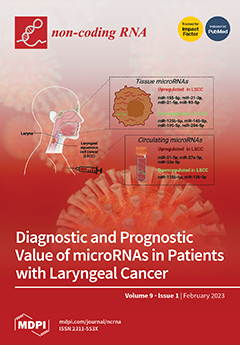The
KALRN gene encodes several multi-domain protein isoforms that localize to neuronal synapses, conferring the ability to grow and retract dendritic spines and shaping axonal outgrowth, dendrite morphology, and dendritic spine re-modeling. The
KALRN genomic locus is implicated in several neurodevelopmental and neuropsychiatric
[...] Read more.
The
KALRN gene encodes several multi-domain protein isoforms that localize to neuronal synapses, conferring the ability to grow and retract dendritic spines and shaping axonal outgrowth, dendrite morphology, and dendritic spine re-modeling. The
KALRN genomic locus is implicated in several neurodevelopmental and neuropsychiatric diseases, including autism, schizophrenia, bipolar disease, and intellectual disability. We have previously shown that a novel brain-specific long non-coding RNA (lncRNA) arising from the 5′ end of the
kalrna gene, called
durga, regulates neuronal morphology in zebrafish. Here, we characterized mammalian
Kalrn loci, annotating and experimentally validating multiple novel non-coding RNAs, including linear and circular variants. Comparing the mouse and human loci, we show that certain non-coding RNAs and
Kalrn protein-coding isoforms arising from the locus show similar expression dynamics during development. In humans, mice, and zebrafish, the 5′ end of the
Kalrn locus gives rise to a chromatin-associated lncRNA that is present in adult ovaries, besides being expressed during brain development and enriched in certain regions of the adult brain. Ectopic expression of this lncRNA led to the downregulation of all the major
Kalrn mRNA isoforms. We propose that this lncRNA arising from the 5′ end of the
Kalrn locus is functionally the mammalian ortholog of zebrafish lncRNA
durga.
Full article






